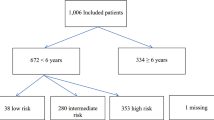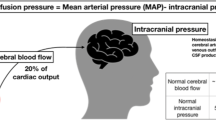Abstract
Objective
A handheld device using near-infrared technology (Infrascanner) has shown good accuracy for detection of traumatic intracranial haemorrhages in adults. This study aims to determine the feasibility of use of Infrascanner in children with minor head injury (MHI) in the Emergency Department (ED). Secondary aim was to assess its potential usefulness to reduce CT scan rate.
Methods
Prospective pilot study conducted in two paediatric EDs, including children at high or intermediate risk for clinically important traumatic brain injury (ciTBI) according to the adapted PECARN rule in use. Completion of Infrascanner measurements and time to completion were recorded. Decision on CT scan and CT scan reporting were performed independently and blinded to Infrascanner results.
Results
Completion of the Infrascanner measurement was successfully achieved in 103 (94 %) of 110 patients enrolled, after a mean of 4.4 ± 2.9 min. A CT scan was performed in 18 (17.5 %) children. Only one had an intracranial haemorrhage that was correctly identified by the Infrascanner. The exploratory analysis showed a specificity of 93 % (95 % CI, 86.5–96.6) and a negative predictive value of 100 % (95 % CI, 81.6–100) for ciTBI. The use of Infrascanner would have led to avoid ten CT scan, reducing the CT scan rate by 58.8 %.
Conclusions
Infrascanner seems an easy-to-use tool for children presenting to the ED following a MHI, given the high completion rate and short time to completion. Our preliminary results suggest that Infrascanner is worthy of further investigation as a potential tool to decrease the CT scan rate in children with MHI.



Similar content being viewed by others
References
Brenner DJ, Hall EJ (2007) Computed tomography—an increasing source of radiation exposure. N Engl J Med 357:2277–2284
Bressan S, Romanato S, Mion T, Zanconato S, Da Dalt L (2012) Implementation of adapted PECARN decision rule for children with minor head injury in the pediatric emergency department. Acad Emerg Med 19:801–807
Coskun F, Sezer EA, Karamercan MA, Akinci E, Vural K (2010) An assessment on the use of infrascanner for the diagnosis of the brain hematoma using support vector machine. Scientific Research and Essays 5:1911–1915
Cravero JP, Blike GT, Beach M et al (2006) Incidence and nature of adverse events during pediatric sedation/anesthesia for procedures outside the operating room: report from the Pediatric Sedation Research Consortium. Pediatrics 118:1087–1096
Da Dalt L, Marchi AG, Laudizi L et al (2006) Predictors of intracranial injuries in children after blunt head trauma. Eur J Pediatr 165:142–148
Dunning J, Daly JP, Lomas JP, Lecky F, Batchelor J, Mackway-Jones K (2006) Derivation of the children’s head injury algorithm for the prediction of important clinical events decision rule for head injury in children. Arch Dis Child 91:885–891
Faul M, Xu L, Wald MW, Coronado VG (2010) Traumatic brain injury in the United States—emergency department visits, hospitalizations and deaths 2002–2006. US Department of Health and Human Services; Center for Disease Control and Prevention. National Center for Injury Prevention and Control.
Francis SV, Ravindran G, Visvanathan K, Ganapathy K (2005) Screening for unilateral intracranial abnormalities using near infrared spectroscopy: a preliminary report. J Clin Neurosci 12:291–295
Ghalenoui H, Saidi H, Azar M, Yahyavi ST, Borghei Razavi H, Khalatbari M (2008) Near-infrared laser spectroscopy as a screening tool for detecting hematoma in patients with head trauma. Prehosp Disaster Med 23:558–561
Gopinath SP, Robertson CS, Contant CF, Narayan RK, Grossman RG, Chance B (1995) Early detection of delayed traumatic intracranial hematomas using near-infrared spectroscopy. J Neurosurg 83:438–444
Gopinath SP, Robertson CS, Grossman RG, Chance B (1993) Near-infrared spectroscopic localization of intracranial hematomas. J Neurosurg 79:43–47
Kahraman S, Kayali H, Atabey C, Acar F, Gocmen S (2006) The accuracy of near-infrared spectroscopy in detection of subdural and epidural hematomas. J Trauma 61:1480–1483
Kessel B, Jeroukhimov I, Ashkenazi I et al (2007) Early detection of life-threatening intracranial haemorrhage using a portable near-infrared spectroscopy device. Injury 38:1065–1068
Kuppermann N, Holmes JF, Dayan PS et al (2009) Identification of children at very low risk of clinically-important brain injuries after head trauma: a prospective cohort study. Lancet 374:1160–1170
Leon-Carrion J, Dominguez-Roldan JM, Leon-Dominguez U, Murillo-Cabezas F (2010) The Infrascanner, a handheld device for screening in situ for the presence of brain haematomas. Brain Inj 24:1193–1201
Lyttle MD, Crowe L, Oakley E, Dunning J, Babl FE (2012) Comparing CATCH, CHALICE and PECARN clinical decision rules for paediatric head injuries. Emerg Med J 29:785–794
Malviya S, Voepel-Lewis T, Eldevik OP, Rockwell DT, Wong JH, Tait AR (2000) Sedation and general anaesthesia in children undergoing MRI and CT: adverse events and outcomes. Br J Anaesth 84:743–748
Mathews JD, Forsythe AV, Brady Z et al (2013) Cancer risk in 680 000 people exposed to computed tomography scans in childhood or adolescence: data linkage study of 11 million Australians. BMJ 346:f2360
McKinlay A, Grace RC, Horwood LJ, Fergusson DM, Ridder EM, MacFarlane MR (2008) Prevalence of traumatic brain injury among children, adolescents and young adults: prospective evidence from a birth cohort. Brain Inj 22:175–181
Pandor A, Goodacre S, Harnan S et al (2011) Diagnostic management strategies for adults and children with minor head injury: a systematic review and an economic evaluation. Health Technol Assess 15:1–202
Pearce MS, Salotti JA, Little MP et al (2012) Radiation exposure from CT scans in childhood and subsequent risk of leukaemia and brain tumours: a retrospective cohort study. Lancet 380:499–505
Osmond MH, Klassen TP, Wells GA et al (2010) CATCH: a clinical decision rule for the use of computed tomography in children with minor head injury. CMAJ 182:341–348
Robertson CS, Gopinath S, Chance B (1997) Use of near infrared spectroscopy to identify traumatic intracranial hemotomas. J Biomed Opt 2:31–41
Robertson CS, Zager EL, Narayan RK et al (2010) Clinical evaluation of a portable near-infrared device for detection of traumatic intracranial hematomas. J Neurotrauma 27:1597–1604, 25
Salonia R, Bell MJ, Kochanek PM, Berger RP (2012) The utility of near infrared spectroscopy in detecting intracranial hemorrhage in children. J Neurotrauma 29:1047–1053
Strangman G, Boas DA, Sutton JP (2002) Non-invasive neuroimaging using near-infrared light. Biological psychiatry 52:679–693
Acknowledgments
The authors thank Chiara Stefani, MD, and Giovanni Dei Tos, Medical Student for their contribution in patients’ enrolment and data collection. The authors thank Davide Pilotto and Gilberto Bottaro, from SEDA S.p.A., for training the study operators and for the assistance provided with the study device.
Conflict of interest statements
The authors have no conflicts of interest to disclose. The authors have not received any financial support, salary or other personal benefits by SEDA S.p.A. for the present study and do not hold stock in the company. The Infrascanner devices and necessary equipment were provided free-of-charge by the distributor, SEDA S.p.A, for the purpose of this study.
Contributorship
SB conceived the idea of the study, searched the literature, interpreted the final results and drafted the manuscript. MD, FM, DD and FM substantially contributed to the study design, data collection and drafting of the manuscript. IPS substantially contributed by reviewing the literature, interpreting final results and critically reviewing the manuscript. LDD substantially contributed to the conception and design of the study, supervised study conduct, contributed to interpretation of final results and critically reviewed the manuscript.
Author information
Authors and Affiliations
Corresponding author
Rights and permissions
About this article
Cite this article
Bressan, S., Daverio, M., Martinolli, F. et al. The use of handheld near-infrared device (Infrascanner) for detecting intracranial haemorrhages in children with minor head injury. Childs Nerv Syst 30, 477–484 (2014). https://doi.org/10.1007/s00381-013-2314-2
Received:
Accepted:
Published:
Issue Date:
DOI: https://doi.org/10.1007/s00381-013-2314-2




